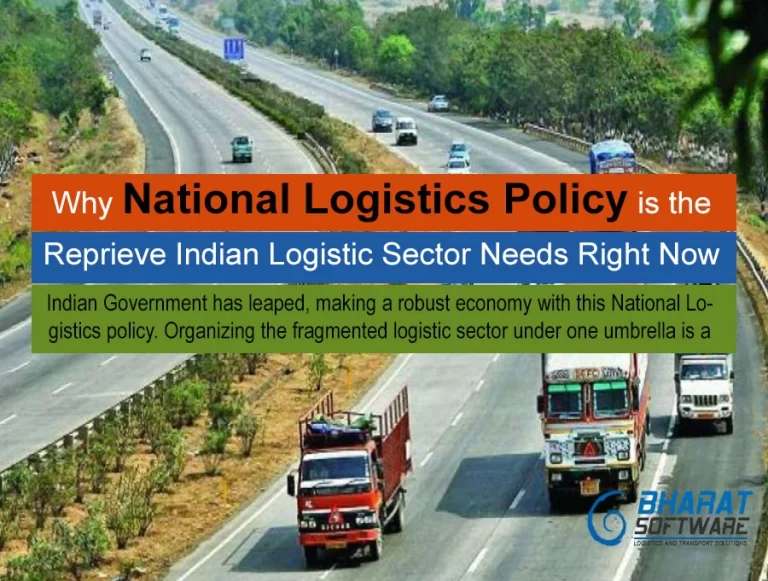National Logistics Policy
Why National Logistics Policy is the Reprieve Indian Logistic Sector Needs Right Now

India’s logistic sector is highly fragmented and unorganized. Therefore, the logistic cost is high, i.e., 14-15% of the GDP. Besides, the number of wastages is also significant.
According to a study, 16% of agricultural production is estimated to be wasted at various supply chain stages.
To address these challenges and mitigate the same, PM Mr. Narendra Modi launched National Logistics Policy or NLP on 17th November 2022. The goal is pretty straightforward- to increase the efficiency in logistics while reducing its cost to make Indian products more competitive domestically and internationally. Besides, this policy aims to develop data-driven tools to help people make informed decisions for better logistics operations.
Continue reading to accumulate more knowledge about National Logistics Policy. Before delving deeper, let’s take the essence of the ongoing issues in our logistics sector.
Current issues in the Indian logistics industry
Indian logistic ecosystem has a plethora of loopholes. Even the tiniest inefficiency can develop untoward situations, directly affecting the logistic cycle. Here you go-
Regulation
Multiple agencies are involved in the movement of goods in the Indian logistics industry. It may lead to delays and complications for the supply chain. On top of that, the regulations by these agencies are frequently updated. It creates an untoward situation for B2B companies as they have to adhere to the regulations to stay compliant. In turn, it directly affects maintaining the delivery deadlines.
Inadequate Infrastructure
Due to the lack of infrastructure, Indian logistics faces significant challenges. The ports, roads, and airports are sometimes poorly maintained and overcrowded, leading to higher costs and delays.
Limited Usage of Technology
Indian logistics industry still misses the touch of emerging technologies, a boon for business owners. Due to the less usage of modern tools, the benefits of it are still left untreated. Therefore, using the traditional procedure takes longer than using transport management software.
Inefficiency of the Supply Chain
Bottlenecks and delays are causing more issues within the logistics industry in India. It lacks advanced planning and scheduling systems, which helps to build an efficient supply chain.
Shortage of Skilled Labor
There is an ongoing shortage of competent workers in the Indian logistics industry. Also, the lack of proper training and development programs results in insufficient knowledge among the workers.
What is NLP?
To address the inefficiency of the Indian logistics sector and high cost, the Government of India made a comprehensive effort by introducing the National Logistics policy. This policy also addresses the aspects like generating more employment opportunities, boosting economic growth, and lowering logistics costs by developing a multi-model system with the help of digitization.
The vision of the Indian Government is clear. It involves implementing robust planning to secure a world-class digital infrastructure for the logistics sector. Besides, the Government also wants that Indian products become more competitive domestically and internationally.
What NLP brings to the logistics sector?
NLP wants to bring businesses, intermediaries, freight companies, and stakeholders under one umbrella. NLP achieves this with the help of a Comprehensive Logistics Action Plan or CLAP. It encompasses the specific target of NLP. The steps are following-
ULIP (Unified Logistics Interface Platform)
ULIP facilitates seamless access to stakeholders for securing the information available with the ministries. It ensures smoother cargo movement across India.
IDS (Integration of Digital Systems)
IDS integrates departments like roadways, railways, aviation, commerce, foreign trade, etc., to ensure the seamless transferring of data in real time.
ELOG (Ease of logistics)
This digital platform brings industry associations together. It can take up the issues related to the performance and operations of the Government. It ensures the accessibility and transparency of the logistics sector.
SIGs (System Improvement Groups)
This group has the vision to improve communication across the ministries. The SIG gives advice based on the existing laws regarding cargo movement across the country.
Targets of National Logistic Policy
ULIP facilitates seamless access to stakeholders for securing the information available with the ministries. It ensures smoother cargo movement across India.
To Normalize the Last Mile Delivery
Ensuring last mile delivery while controlling costs needs a careful evaluation. NLP encourages logistic companies to use emerging technologies like advanced route planning, data analytics, and telematics to turn last-mile delivery into a success. It will elevate the customer delivery experience by accumulating intelligent data in real time.
To Reduce Product Wastage
NLP aims to reduce the waste in the supply chain. It will not only help the logistics companies to reduce their monthly garbage bills, but it will also generate the maximum rates of recycling revenue. From examining the product design to implementing quality control, this policy encapsulates the benefits of producing less waste.
To Eliminate the Logistics-related Challenges
Increasing transportation costs, limited shipment visibility, tracking inconsistencies, fragmented communication, and delivery delays are some of the potential issues the Indian logistic sector is facing. NLP addresses these issues to remove them from the logistic ecosystem.
To ensure time and cost-effectiveness
One of the primary focuses of NLP is to minimize the logistic expenses for business operations. This policy aims to bring the proper supply chain strategies in place so that the companies can improve their efficiencies. Therefore, it will ensure maximum efficacy against the spent time and cost.
To Implement the Standardized Internal Process
The involvement of critical elements in the supply chain needs a standardized process, including shipment, warehousing, material procurement, packaging, and delivery. NLP and its implementation improve transparency while offering customers greater visibility.
To help make data-driven decisions
NLP aims to help supply chain experts and management they can make data-driven decisions. It will help to create an efficient logistics ecosystem.
How will the NLP be Executed?
NLP will be implemented through a comprehensive logistic action plan (CLAP). Here you go-
(a) Integrated digital logistics system
Developing a unified logistics interface to link multiple data sources can be implemented. Developing cross-sectoral use cases can be another pathway to create integrated digital logistics management software for the stakeholders.
(b) Engagement of states
Supporting state-wise logistic plans would help set up the institutional framework. Measure and monitor the actions of states and rank them accordingly.
(c) Physical Assets Standardization
Standardizing physical assets enhances interoperability, optimizes processes, minimizes handling risks, and improves business operations.
(d) Export-Import logistics
Address the infrastructure and procedural gaps in India’s export-import connectivity. It helps to create a reliable and efficient logistics network with cross-border trade facilitation. It facilitates the trade competitiveness of India with global and regional value chains.
(e) Sectoral Plans
Aligned with PM GatiShakti, SPEL or sectoral plans for efficient logistics will be curated for each logistics sector involving philosophies of resiliency, interoperability, sustainability, etc.
(f) Logistics Parks Development
Logistics parks are considered the hubs of intermediary activities like handling, storage, intermodal transfers, etc. Creating the framework guidelines is necessary to facilitate the development of logistics parks. Besides, creating the network of logistic parks by mapping it on PM GatiShakti NMP will improve logistics efficiency, enhance visibility and optimize the utilization of the supply chain.
What is the Future of NLP?
NLP aims to rejuvenate the logistic operations in India. The future of NLP depends on the success of various infrastructure programs. Initiatives like Bharatmala and Sagarmala that focus on road and water connectivity across India will decide the future of NLP. Improvizing the supply chain ecosystem is the main objective of NLP. It acts as the bridge between the B2B and B2C players to provide seamless logistics services.
Wrapping it up
Indian Government has leaped, making a robust economy with this National Logistics policy. Organizing the fragmented logistic sector under one umbrella is a great initiative. Once the multiple stakeholders start implementing it, the target for the greater good can be achieved over time with the help of the tech-enabled solution. It will ultimately skyrocket the growth of the logistic ecosystem and supply chain.

A content writer who dwells on writing while finding new adventures around words. Having experience working for SaaS and start-ups, I found the unwavering will inside me to meet new people, develop new relationships, solve issues and contribute to their business growth.
